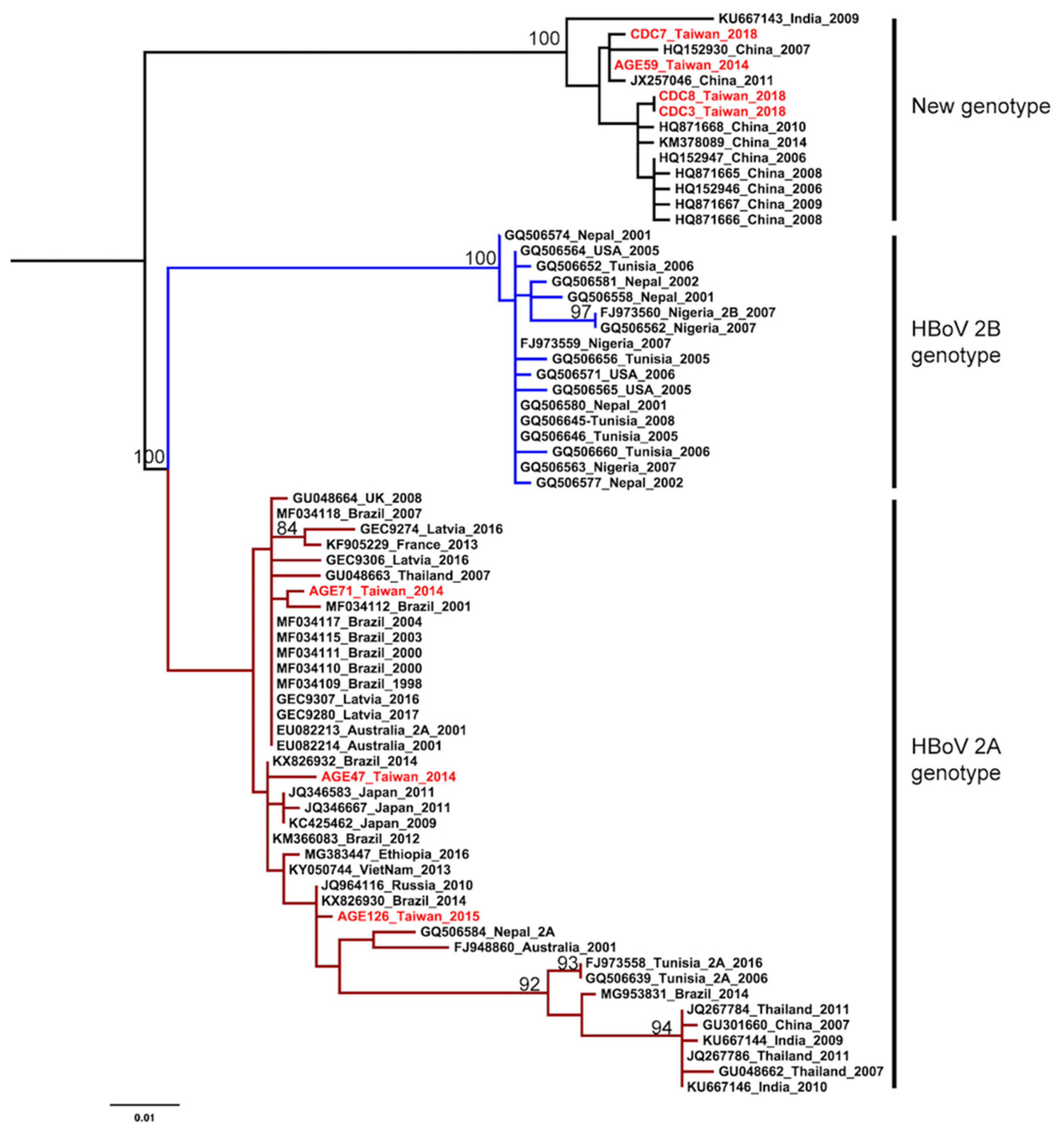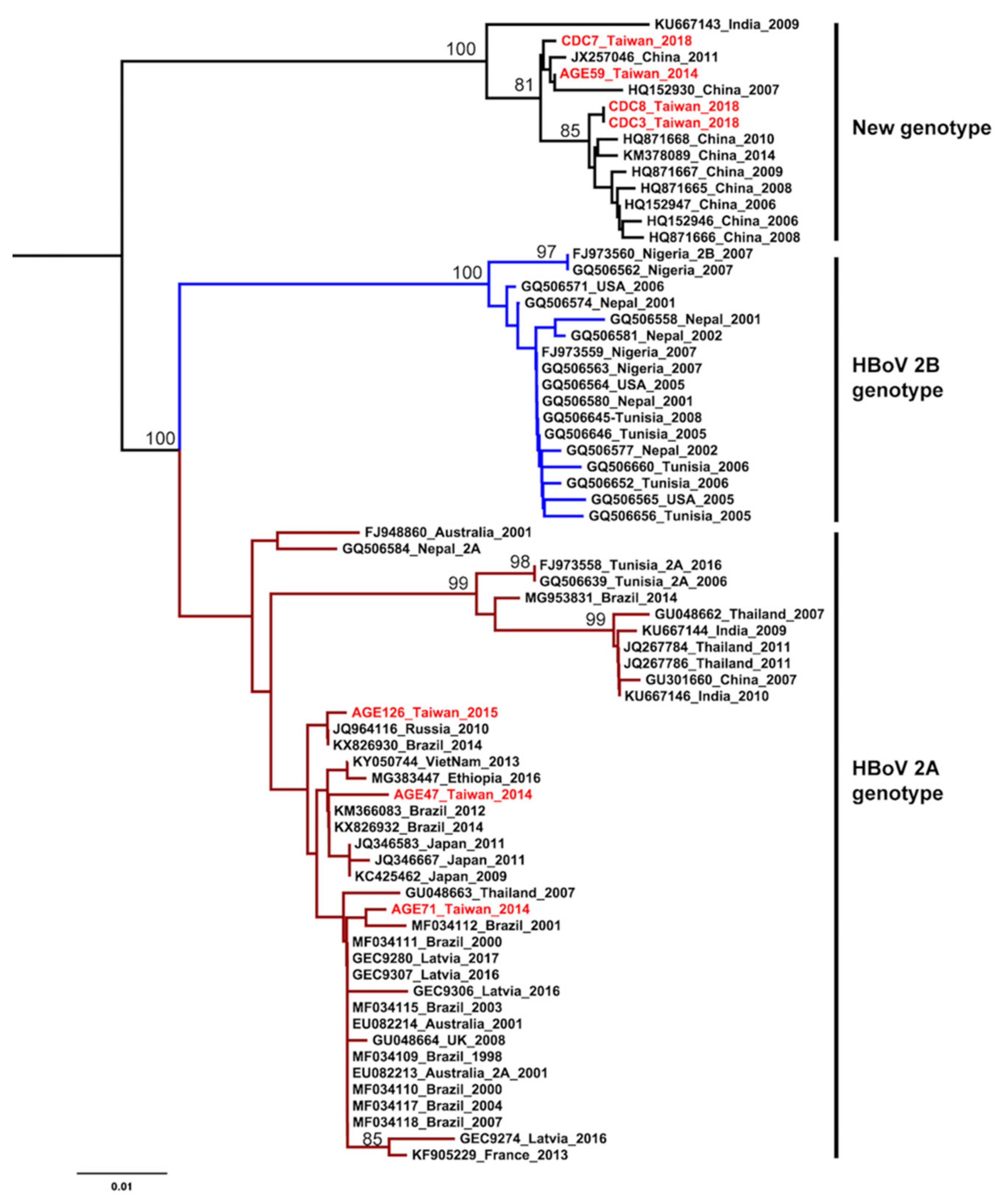Genetic Diversity and Phylogenetic Analysis of Human Bocavirus 2 in Pediatric Patients with Acute Gastroenteritis in Taiwan
Abstract
1. Introduction
2. Materials and Methods
2.1. Specimen Selection and Ethics Statement
2.2. Virus Detection and Genotype Classification
2.3. Phylogenetic Analyses
2.4. Selection Pressure of VP1 Protein Genes
3. Results
3.1. Sequence Comparison and Phylogenetic Analysis of HBoV2
3.2. Selection Pressures in the HBoV2 VP1 Protein Genes
4. Discussion
5. Conclusions
Author Contributions
Funding
Conflicts of Interest
References
- Allander, T.; Tammi, M.T.; Eriksson, M.; Bjerkner, A.; Tiveljung-Lindell, A.; Andersson, B. Cloning of a human parvovirus by molecular screening of respiratory tract samples. Proc. Natl. Acad. Sci. USA 2005, 102, 12891–12896. [Google Scholar] [CrossRef]
- Kapoor, A.; Simmonds, P.; Slikas, E.; Li, L.; Bodhidatta, L.; Sethabutr, O.; Triki, H.; Bahri, O.; Oderinde, B.S.; Baba, M.M.; et al. Human bocaviruses are highly diverse, dispersed, recombination prone, and prevalent in enteric infections. J. Infect. Dis. 2010, 201, 1633–1643. [Google Scholar] [CrossRef]
- Kapoor, A.; Slikas, E.; Simmonds, P.; Chieochansin, T.; Naeem, A.; Shaukat, S.; Alam, M.M.; Sharif, S.; Angez, M.; Zaidi, S.; et al. A newly identified bocavirus species in human stool. J. Infect. Dis. 2009, 199, 196–200. [Google Scholar] [CrossRef] [PubMed]
- Arthur, J.L.; Higgins, G.D.; Davidson, G.P.; Givney, R.C.; Ratcliff, R.M. A novel bocavirus associated with acute gastroenteritis in Australian children. PLoS Pathog. 2009, 5. [Google Scholar] [CrossRef] [PubMed]
- Khamrin, P.; Malasao, R.; Chaimongkol, N.; Ukarapol, N.; Kongsricharoern, T.; Okitsu, S.; Hayakawa, S.; Ushijima, H.; Maneekarn, N. Circulating of human bocavirus 1, 2, 3, and 4 in pediatric patients with acute gastroenteritis in Thailand. Infect. Genet. Evol. 2012, 12, 565–569. [Google Scholar] [CrossRef] [PubMed]
- Lin, J.H.; Chiu, S.C.; Lin, Y.C.; Chen, H.L.; Lin, K.H.; Shan, K.H.; Wu, H.S.; Liu, H.F. Clinical and genetic analysis of Human Bocavirus in children with lower respiratory tract infection in Taiwan. J. Clin. Virol. 2009, 44, 219–224. [Google Scholar] [CrossRef] [PubMed]
- Mitui, M.T.; Tabib, S.M.; Matsumoto, T.; Khanam, W.; Ahmed, S.; Mori, D.; Akhter, N.; Yamada, K.; Kabir, L.; Nishizono, A.; et al. Detection of human bocavirus in the cerebrospinal fluid of children with encephalitis. Clin. Infect. Dis. 2012, 54, 964–967. [Google Scholar] [CrossRef] [PubMed]
- Mori, D.; Ranawaka, U.; Yamada, K.; Rajindrajith, S.; Miya, K.; Perera, H.K.; Matsumoto, T.; Dassanayake, M.; Mitui, M.T.; Mori, H.; et al. Human bocavirus in patients with encephalitis, Sri Lanka, 2009–2010. Emerg. Infect. Dis. 2013, 19, 1859–1862. [Google Scholar] [CrossRef]
- Nora-Krukle, Z.; Vilmane, A.; Xu, M.; Rasa, S.; Ziemele, I.; Silina, E.; Soderlund-Venermo, M.; Gardovska, D.; Murovska, M. Human Bocavirus Infection Markers in Peripheral Blood and Stool Samples of Children with Acute Gastroenteritis. Viruses 2018, 10, 639. [Google Scholar] [CrossRef]
- Christensen, A.; Kesti, O.; Elenius, V.; Eskola, A.L.; Dollner, H.; Altunbulakli, C.; Akdis, C.A.; Soderlund-Venermo, M.; Jartti, T. Human bocaviruses and paediatric infections. Lancet Child Adolesc. Health 2019, 3, 418–426. [Google Scholar] [CrossRef]
- Khamrin, P.; Okitsu, S.; Ushijima, H.; Maneekarn, N. Complete genome sequence analysis of novel human bocavirus reveals genetic recombination between human bocavirus 2 and human bocavirus 4. Infect. Genet. Evol. 2013, 17, 132–136. [Google Scholar] [CrossRef] [PubMed]
- Zhao, M.; Zhu, R.; Qian, Y.; Deng, J.; Wang, F.; Sun, Y.; Dong, H.; Liu, L.; Jia, L.; Zhao, L. Prevalence analysis of different human bocavirus genotypes in pediatric patients revealed intra-genotype recombination. Infect. Genet. Evol. 2014, 27, 382–388. [Google Scholar] [CrossRef] [PubMed]
- Clark, B.; McKendrick, M. A review of viral gastroenteritis. Curr. Opin. Infect. Dis. 2004, 17, 461–469. [Google Scholar] [CrossRef] [PubMed]
- Chen, S.Y.; Chang, Y.C.; Lee, Y.S.; Chao, H.C.; Tsao, K.C.; Lin, T.Y.; Ko, T.Y.; Tsai, C.N.; Chiu, C.H. Molecular epidemiology and clinical manifestations of viral gastroenteritis in hospitalized pediatric patients in Northern Taiwan. J. Clin. Microbiol. 2007, 45, 2054–2057. [Google Scholar] [CrossRef][Green Version]
- Chen, C.J.; Wu, F.T.; Huang, Y.C.; Chang, W.C.; Wu, H.S.; Wu, C.Y.; Lin, J.S.; Huang, F.C.; Hsiung, C.A. Clinical and Epidemiologic Features of Severe Viral Gastroenteritis in Children: A 3-Year Surveillance, Multicentered Study in Taiwan With Partial Rotavirus Immunization. Medicine 2015, 94. [Google Scholar] [CrossRef]
- Tang, M.B.; Chu, C.M.; Chou, Y.C.; Kuan, J.C.; Yu, C.P. Molecular Detection of Human Bocavirus 1 and 2 in Children with Acute Gastroenteritis in Taiwan. Southeast Asian J. Trop. Med. Public Health 2015, 46, 1005–1012. [Google Scholar]
- Edgar, R.C. MUSCLE: Multiple sequence alignment with high accuracy and high throughput. Nucleic Acids Res. 2004, 32, 1792–1797. [Google Scholar] [CrossRef]
- Kumar, S.; Stecher, G.; Tamura, K. MEGA7: Molecular Evolutionary Genetics Analysis Version 7.0 for Bigger Datasets. Mol. Biol. Evol. 2016, 33, 1870–1874. [Google Scholar] [CrossRef]
- Lefort, V.; Longueville, J.E.; Gascuel, O. SMS: Smart Model Selection in PhyML. Mol. Biol. Evol. 2017, 34, 2422–2424. [Google Scholar] [CrossRef]
- Guindon, S.; Dufayard, J.F.; Lefort, V.; Anisimova, M.; Hordijk, W.; Gascuel, O. New algorithms and methods to estimate maximum-likelihood phylogenies: Assessing the performance of PhyML 3.0. Syst. Biol. 2010, 59, 307–321. [Google Scholar] [CrossRef]
- Kosakovsky Pond, S.L.; Frost, S.D. Not so different after all: A comparison of methods for detecting amino acid sites under selection. Mol. Biol. Evol. 2005, 22, 1208–1222. [Google Scholar] [CrossRef] [PubMed]
- Murrell, B.; Moola, S.; Mabona, A.; Weighill, T.; Sheward, D.; Kosakovsky Pond, S.L.; Scheffler, K. FUBAR: A fast, unconstrained bayesian approximation for inferring selection. Mol. Biol. Evol. 2013, 30, 1196–1205. [Google Scholar] [CrossRef] [PubMed]
- Weaver, S.; Shank, S.D.; Spielman, S.J.; Li, M.; Muse, S.V.; Kosakovsky Pond, S.L. Datamonkey 2.0: A modern web application for characterizing selective and other evolutionary processes. Mol. Biol. Evol. 2018. [Google Scholar] [CrossRef] [PubMed]
- Rambaut, A.; Lam, T.T.; Max Carvalho, L.; Pybus, O.G. Exploring the temporal structure of heterochronous sequences using TempEst (formerly Path-O-Gen). Virus Evol. 2016, 2. [Google Scholar] [CrossRef]
- Chow, B.D.; Ou, Z.; Esper, F.P. Newly recognized bocaviruses (HBoV, HBoV2) in children and adults with gastrointestinal illness in the United States. J. Clin. Virol. 2010, 47, 143–147. [Google Scholar] [CrossRef]
- Lasure, N.; Gopalkrishna, V. Molecular epidemiology and clinical severity of Human Bocavirus (HBoV) 1-4 in children with acute gastroenteritis from Pune, Western India. J. Med. Virol. 2017, 89, 17–23. [Google Scholar] [CrossRef]
- Mitui, M.T.; Bozdayi, G.; Ahmed, S.; Matsumoto, T.; Nishizono, A.; Ahmed, K. Detection and molecular characterization of diarrhea causing viruses in single and mixed infections in children: A comparative study between Bangladesh and Turkey. J. Med. Virol. 2014, 86, 1159–1168. [Google Scholar] [CrossRef]
- Cheng, W.; Chen, J.; Xu, Z.; Yu, J.; Huang, C.; Jin, M.; Li, H.; Zhang, M.; Jin, Y.; Duan, Z.J. Phylogenetic and recombination analysis of human bocavirus 2. BMC Infect. Dis. 2011, 11, 50. [Google Scholar] [CrossRef]
- Zhirakovskaia, E.; Tikunov, A.; Tymentsev, A.; Sokolov, S.; Sedelnikova, D.; Tikunova, N. Changing pattern of prevalence and genetic diversity of rotavirus, norovirus, astrovirus, and bocavirus associated with childhood diarrhea in Asian Russia, 2009–2012. Infect. Genet. Evol. 2019, 67, 167–182. [Google Scholar] [CrossRef]


| Laboratory Numbers/Accession Numbers | Country | Source | Year |
|---|---|---|---|
| AGE-47, AGE-59, AGE-71, AGE-126 | Taiwan | This study | 2014 |
| CDC3, CDC7, CDC8 | Taiwan | Centers for Disease Control, Taiwan | 2018 |
| GEC-9274, GEC-9280, GEC-9306, GEC-9307 | Latvia | Riga Stradins University | 2016–2017 |
| EU082213-4, FJ948860 | Australia | NCBI | 2001 |
| FJ973558-60 | Tunisia | NCBI | 2016 |
| FJ973559-60, GQ506562-3 | Nigeria | NCBI | 2007 |
| GQ506584 | Nigeria | NCBI | |
| GQ506564-5, GQ506571, | USA | NCBI | 2005–2006 |
| GQ506558, GQ506574, GQ506577, GQ506580-1 | Nepal | NCBI | 2001–2002 |
| GQ506639, GQ506645-6, GQ506652, GQ506656, GQ506660 | Tunisia | NCBI | 2005–2008 |
| GU048662-3, JQ267784, JQ267786 | Thailand | NCBI | 2007–2011 |
| GU048664 | UK | NCBI | 2008 |
| GU301660, HQ152930, HQ152946-7, HQ871665, HQ871666-8, JX257046, KM378089 | China | NCBI | 2006–2014 |
| KC425462, JQ346583, JQ346667 | Japan | NCBI | 2009–2011 |
| JQ964116 | Russia | NCBI | 2010 |
| KF905229 | France | NCBI | 2013 |
| KM366083, KX826930, KX826932, MF034109-12, MF034115, MF034117-8, MG953831 | Brazil | NCBI | 1998–2014 |
| KU667143-4, KU667146 | India | NCBI | 2009–2010 |
| KY050744 | Viet Nam | NCBI | 2013 |
| MG383447 | Ethiopia | NCBI | 2016 |
| HBoV2Aa | HBoV2Bb | AGE-47 | AGE-71 | AGE-126 | AGE-59 | CDC3 | CDC7 | CDC8 | |
|---|---|---|---|---|---|---|---|---|---|
| HBoV2A | |||||||||
| AGE-47 | 1.1% | 6.4% | 1.6% | 1.1% | 6.8% | 7.3% | 7.1% | 7.3% | |
| AGE-71 | 0.5% | 6.2% | 1.6% | 1.4% | 6.8% | 7.3% | 7.1% | 7.3% | |
| AGE-126 | 0.9% | 5.7% | 1.1% | 1.4% | 6.6% | 7.1% | 6.8% | 7.1% | |
| Novel HBoV2 | |||||||||
| AGE-59 | 6.4% | 9.1% | 6.8% | 6.8% | 6.6% | 0.9% | 0.2% | 0.9% | |
| CDC3 | 6.6% | 9.1% | 7.3% | 7.3% | 7.1% | 0.9% | 0.7% | 0% | |
| CDC7 | 6.8% | 8.9% | 7.1% | 7.1% | 6.8% | 0.2% | 0.7% | 0.7% | |
| CDC8 | 6.8% | 9.1% | 7.3% | 7.3% | 7.1% | 0.9% | 0% | 0.7% |
| Positively Selected Sites | No. of NEGATIVELY Selected Sites | Mean dN/dS | |||||
|---|---|---|---|---|---|---|---|
| SLACa | FELa | FUBAb | SLACa | FELa | FUBAb | ||
| Non | Non | Non | 16 | 34 | 26 | 0.080 | |
© 2020 by the authors. Licensee MDPI, Basel, Switzerland. This article is an open access article distributed under the terms and conditions of the Creative Commons Attribution (CC BY) license (http://creativecommons.org/licenses/by/4.0/).
Share and Cite
Lin, M.Y.-C.; Chan, H.-C.; Chi, H.; Chiu, S.-C.; Nora-Krukle, Z.; Rasa-Dzelzkaleja, S.; Vilmane, A.; Murovska, M.; Lin, J.-H.; Liu, H.-F. Genetic Diversity and Phylogenetic Analysis of Human Bocavirus 2 in Pediatric Patients with Acute Gastroenteritis in Taiwan. Int. J. Environ. Res. Public Health 2020, 17, 1086. https://doi.org/10.3390/ijerph17031086
Lin MY-C, Chan H-C, Chi H, Chiu S-C, Nora-Krukle Z, Rasa-Dzelzkaleja S, Vilmane A, Murovska M, Lin J-H, Liu H-F. Genetic Diversity and Phylogenetic Analysis of Human Bocavirus 2 in Pediatric Patients with Acute Gastroenteritis in Taiwan. International Journal of Environmental Research and Public Health. 2020; 17(3):1086. https://doi.org/10.3390/ijerph17031086
Chicago/Turabian StyleLin, Marco Yung-Cheng, Hsiu-Chuan Chan, Hsin Chi, Shu-Chun Chiu, Zaiga Nora-Krukle, Santa Rasa-Dzelzkaleja, Anda Vilmane, Modra Murovska, Jih-Hui Lin, and Hsin-Fu Liu. 2020. "Genetic Diversity and Phylogenetic Analysis of Human Bocavirus 2 in Pediatric Patients with Acute Gastroenteritis in Taiwan" International Journal of Environmental Research and Public Health 17, no. 3: 1086. https://doi.org/10.3390/ijerph17031086
APA StyleLin, M. Y.-C., Chan, H.-C., Chi, H., Chiu, S.-C., Nora-Krukle, Z., Rasa-Dzelzkaleja, S., Vilmane, A., Murovska, M., Lin, J.-H., & Liu, H.-F. (2020). Genetic Diversity and Phylogenetic Analysis of Human Bocavirus 2 in Pediatric Patients with Acute Gastroenteritis in Taiwan. International Journal of Environmental Research and Public Health, 17(3), 1086. https://doi.org/10.3390/ijerph17031086







